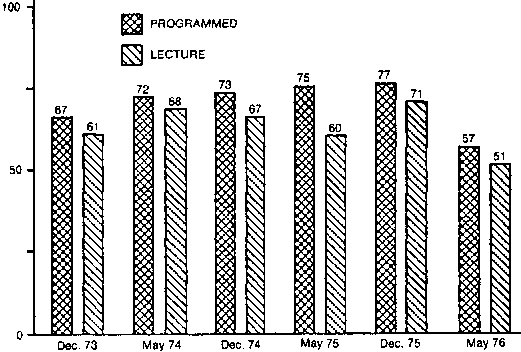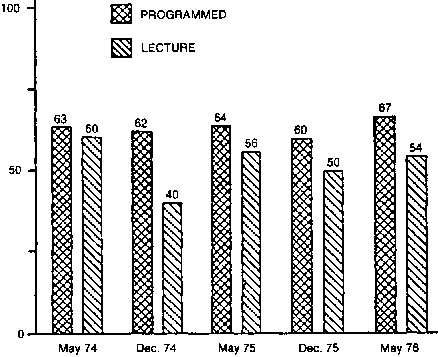
Helen L. Plants and Wallace S. Venable, West Virginia University
Engineering Education, February 1985 - page 277
In the fall of 1962 the first programmed instruction module was introduced in a Mechanics of Materials class of about 30 students at West Virginia University. Today, 22 years later, 406 students in 13 sections of Statics, Dynamics, and Mechanics of Materials are taught exclusively from programmed texts, while 233 in eight sections study the same subjects in the traditional manner.
The use of programmed instruction at West Virginia University has grown steadily throughout the years. Far from being merely the project of a few dedicated individuals, it has survived many changes of personnel.
Programmed instruction has had the support of five different chairmen of the mechanical engineering department and of four different deans. It has involved dozens of faculty, more than a hundred undergraduate tutor/graders, and a cast of thousands of undergraduate students. Most important, the program has been directed by four different faculty members and has survived the retirement and departure of its originator. In no way can it be seen as an individual triumph, nor does it depend for success on the continued effort of any one individual. Programmed instruction at West Virginia endures by its own merit.
The instructional materials used in the "programmed" courses consist of written linear-programmed instruction. There is a separate set of materials for Statics, for Dynamics and for Mechanics of Materials. Each set includes over 1,000 frames divided into 30 or more study units. Each student is expected to buy a personal copy of the materials. More detailed information on the programs may be found elsewhere. 1, 2
Since programs do differ radically from textbooks, it is not surprising that a different approach must be used by the teacher. There are apparently many ways to use programs effectively in a class, depending on the teacher, the students and the course material. The system in use at WVU has grown up in a sort of trial-and-error manner. Having tried many teaching systems, we are convinced that the system currently in use works best for WVU students and the materials now in use. It has been called Elastically Structured Teaching (EST) since it offers the individual a great deal of flexibility within a rather rigidly structured course.
The system is based on scheduled, required quizzes over each unit of programmed material. Classes meet on a regular schedule. Teachers begin class by distributing tests that cover the previous night's assignments. These tests are designed to be completed in about 15 to 20 minutes. Instructors collect the tests and work them out for the class. They then discuss any questions arising from the day's assignment, and may use any remaining time to show the class personal tricks and applications for the concept.
While classes and quizzes are held regularly, attendance is not required. Students who fall behind may take a make-up quiz in a self-study center. They may also take quizzes ahead of schedule in the center if they wish. A limit is set on late work, and about 80 percent of all quizzes are taken in class. Students dissatisfied with their performance on any of the daily quizzes may go to the center to try an alternative version. All attempts are averaged to arrive at a score for the unit.
Students are permitted to "self-pace" themselves through the courses on an accelerated schedule, but fewer than five percent choose to do so.
Almost every mechanics class since 1968 has been required to take a departmental final examination. These have multiple purposes, including monitoring the effectiveness of individual instructors, providing instructors with a broad norm when assigning grades and evaluating instructional methods.
From 1973 to 1976 special effort was devoted to statistical analysis of the differences between ''Lecture" and "Programmed" classes. (During that time a two-semester "integrated" mechanics sequence was given to all engineering students.) The differences between the methods 3 are shown in figures 1 and 2 and tables 1 and 2. The statistical results strongly favor the programmed instruction. Students in the programmed sections not only have higher average scores, but also show less variability among individuals and among sections than students in lecture classes.


| Semester | Programmed | Lecture | Difference | ||||||
n |
mean |
std dev |
n |
mean |
std dev |
t |
df |
p |
|
| Dec 73 | 55 |
66.85 |
(15)* |
112 |
61.31 |
(18)* |
2.10 |
165 |
.05 |
| May 74 | 22 |
72.64 |
15.39 |
33 |
68.97 |
16.94 |
.83 |
53 |
n.s. |
| Dec 74 | 107 |
72.84 |
12.82 |
99 |
66.70 |
18.02 |
2.80 |
204 |
.01 |
| May 75 | 13 |
75.46 |
13.87 |
43 |
60.19 |
15.95 |
3.36 |
54 |
.01 |
| Dec 75 | 134 |
76.58 |
13.91 |
159 |
70.51 |
15.30 |
3.55 |
291 |
.001 |
| May 76 | 23 |
56.62 |
17.08 |
81 |
50.72 |
16.51 |
1.47 |
102 |
n.s. |
| Total | 354 |
72.36 |
(14.75)* |
415 |
63.86 |
(17.96)* |
7.67 |
879 |
.001 |
* estimated
| Semester | Programmed | Lecture | Difference | ||||||
n |
mean |
std dev |
n |
mean |
std dev |
t |
df |
p |
|
| May 74 | 62 |
62.94 |
16.61 |
92 |
60.03 |
14.57 |
1.12 |
152 |
n.s. |
| Dec 74 | 24 |
62.38 |
16.96 |
24 |
40.17 |
20.12 |
4.13 |
46 |
.001 |
| May 75 | 86 |
64.21 |
13.46 |
95 |
56.20 |
15.54 |
3.72 |
179 |
.001 |
| Dec 75 | 18 |
60.50 |
12.98 |
27 |
49.41 |
11.56 |
4.98 |
43 |
.001 |
| May 76 | 107 |
66.93 |
10.36 |
163 |
54.38 |
15.09 |
8.10 |
268 |
.001 |
| Total | 297 |
64.55 |
13.54 |
401 |
54.92 |
15.84 |
8.64 |
696 |
.001 |
It should be noted, however, that a small but significant number of students in lecture classes perform at a very high level. Several lecture teachers also have a record of excellence in preparing their students for the departmental exams.
In 1976, detailed statistical analysis of the examinations was discontinued. Throughout the entire period since 1968, however, similar patterns in mean scores have been the rule.
The proved effectiveness of programmed instruction is not the only reason for its success at West Virginia University. Effective programs have failed to endure in other institutions. It is difficult to ascertain the reasons for its longevity at WVU, but the following are seen as contributing factors.
Programmed instruction is popular with students and teachers. Many students find that it suits their learning styles better than the more conventional method. Many teachers, after the initial shock of something new, have come to appreciate insights gained by students and the different student-teacher relationship that is developed.
All is not rosy, however. Like all new materials, the programs are plagued with errors, particularly since they are subject to continual change. Because the use of the programs is limited, publishers are reluctant at times to make reprints and corrections in commercially published materials. Programs published locally are subject to the problem of correcting one error while introducing two more in retyping. It is hoped the computer will eventually come to the rescue.
The production of materials and the logistics of grading, feedback and other administrative matters are a continuing source of frustration. Although many problems have become routine, they must be met again each semester. Each successive director finds that his or her first term is best described as harrowing.
For West Virginia University, programmed instruction in mechanics can no longer be described as innovative. It is simply one of the ways things are done. While still subject to continual evaluation, it no longer provides a challenging study to the investigator.
For those who have worked with it for years and years, programmed instruction seems to have gone on and on. It no longer has the attraction of novelty, nor the excitement of discovery. It has become a routine of proved effectiveness, which, it is hoped, will provide an educational advantage to future generations of students.